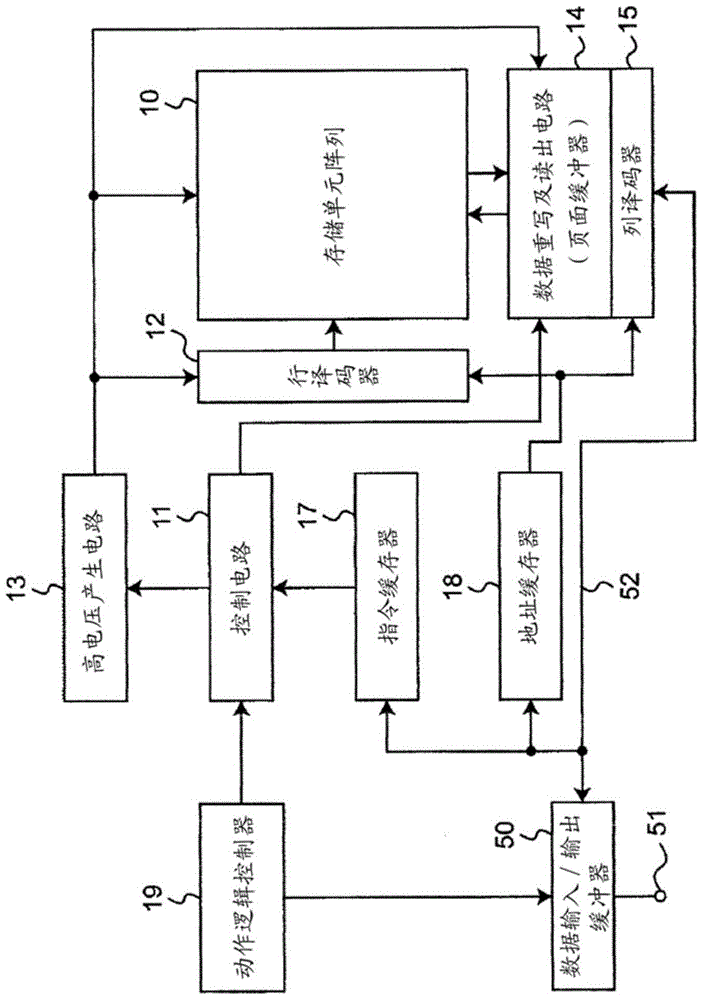Sensing Circuit Used For Non-volatile Memory And Non-volatile Memory
A sensing circuit and voltage technology, applied in information storage, static memory, read-only memory, etc., can solve problems such as the influence of accuracy of electrical characteristics, the difference of jump points, etc., and achieve the effect of accurate data value and accurate sensing
- Summary
- Abstract
- Description
- Claims
- Application Information
AI Technical Summary
Problems solved by technology
Method used
Image
Examples
Embodiment 1
[0175] Figure 7 It is a circuit diagram showing a configuration example of the sensing circuit 30A and the page buffer PBn used in the NAND flash EEPROM of the first embodiment. Figure 7 In the embodiment 1, the sensing circuit 30A is provided corresponding to each page buffer PBn, and is provided between the nodes SNS and SLS1 of the page buffer PBn and the signal line B, and has a stacked gate type An N-channel MOS transistor N1 and two N-channel MOS transistors N2 and N3 each serving as a switch element are configured.
[0176] The control gate of the MOS transistor N1 is connected to the node SNS (sensing node of the page buffer PBn), the floating gate of the MOS transistor N1 is connected to the source of the MOS transistor N2, and the source of the MOS transistor N1 is connected to the signal line B. The drain of the MOS transistor N1 is connected to the source of the MOS transistor N3 and the drain of the MOS transistor N2. And, to the gate of the MOS transistor N2,...
Embodiment 2
[0192] Figure 9 It is a circuit diagram showing a configuration example of the sensing circuit 30B and the page buffer PBn used in the NAND flash EEPROM of the second embodiment. The sensing circuit 30B of Embodiment 2 is used for data programming and verification processing (including when the node voltage SLR1 is low level and programming is performed, and when the node voltage SLR1 is high level but not performed) in addition to data readout. programming case) sensing circuitry, with Figure 7 Compared with the sensing circuit 30A of the first embodiment, the following points are different.
[0193] (1) In addition to the MOS transistors N1 and N2, the sensing circuit 30B further includes an N-channel MOS transistor N5 and an N-channel MOS transistor N4. The N-channel MOS transistor N5 is a switch connected to the signal line A and the node SLS1. component, the N-channel MOS transistor N4 is a switch component that is turned on / off based on the verification judgment swit...
Embodiment 2-1
[0198] Figure 10 is expressed by Figure 9 Flowchart of the data programming and verifying process of Embodiment 2-1 (programming is performed when SLR1=Low and SLR1=0V, SLS1=VDD) executed by the sensing circuit 30B and page buffer PBn of the . Figure 10 Data programming and verification processing and Figure 8 Compared with the data read processing of , the following points are different. In addition, in Figure 10 In each treatment, the bottom line is used to indicate the relationship with Figure 8 The difference in the corresponding processing of , and the difference from the previous corresponding processing is also indicated below with an underline.
[0199] (1) replace Figure 8 The processing of steps S1 to S4 includes the processing of steps S21 and S22.
[0200] (2) replace Figure 8 Steps S8 and S12 of the step S8A and S12A respectively include the processing of steps S8A and S12A.
[0201] (3) After the processing of step S13, execute Figure 11 The pr...
PUM
 Login to View More
Login to View More Abstract
Description
Claims
Application Information
 Login to View More
Login to View More - R&D
- Intellectual Property
- Life Sciences
- Materials
- Tech Scout
- Unparalleled Data Quality
- Higher Quality Content
- 60% Fewer Hallucinations
Browse by: Latest US Patents, China's latest patents, Technical Efficacy Thesaurus, Application Domain, Technology Topic, Popular Technical Reports.
© 2025 PatSnap. All rights reserved.Legal|Privacy policy|Modern Slavery Act Transparency Statement|Sitemap|About US| Contact US: help@patsnap.com



